The ADATA Premier SP550 SSD Review: A Second Look At Silicon Motion's SM2256 Controller
by Billy Tallis on March 23, 2016 8:30 AM ESTMixed Random Read/Write Performance
The mixed random I/O benchmark starts with a pure read test and gradually increases the proprotion of writes, finishing with pure writes. The queue depth is 3 for the entire test and each subtest lasts for 3 minutes, for a total test duration of 18 minutes. As with the pure random write test, this test is restricted to a 16GB span of the drive, which is empty save for the 16GB test file.
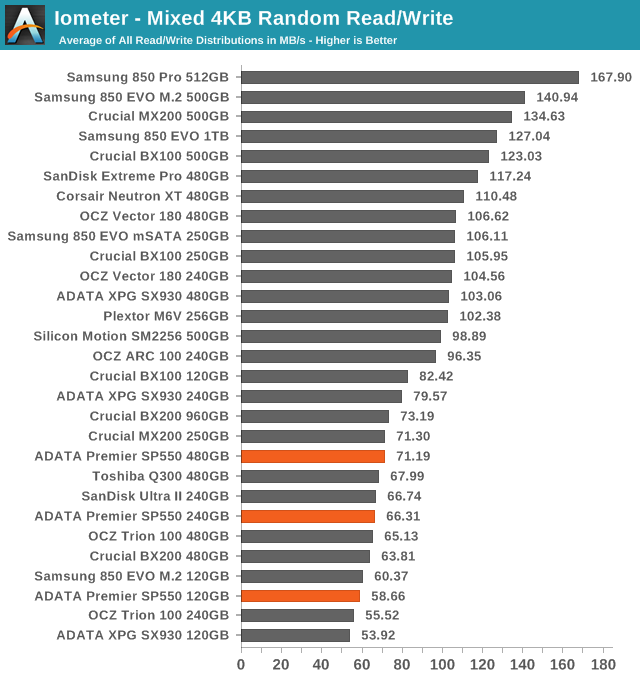
Despite its poor random write speed, the SP550 keeps pace overall with its low-end competition on the mixed random I/O test.
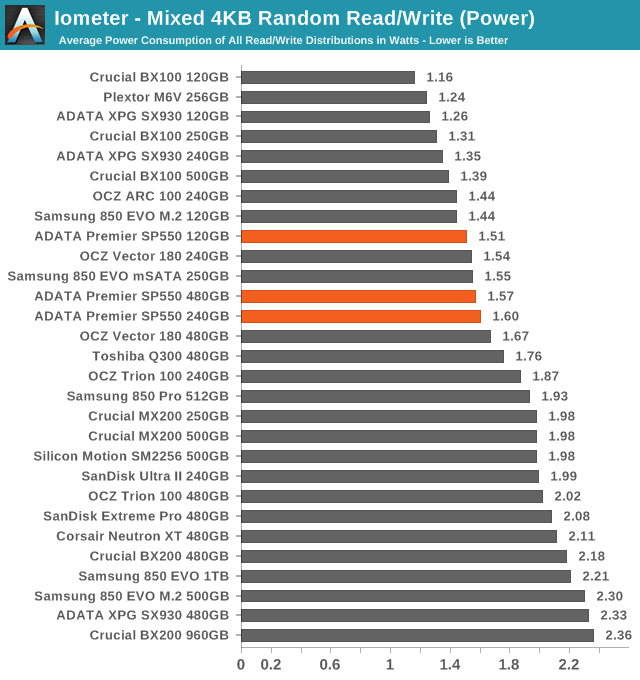
The SP550's power consumption is good but not great, so its efficiency ends up better than competitors like the OCZ Trion 100 and the SanDisk Ultra II, but the high-end drives are delivering performance that more than justifies their higher power consumption.
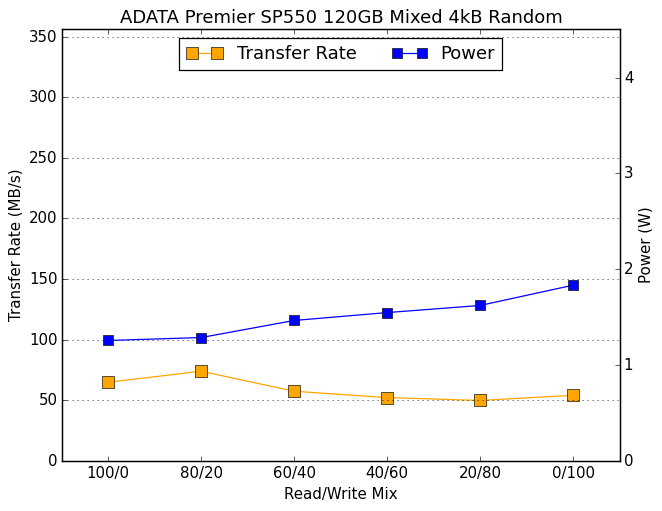 |
|||||||||
The drives that score best on the mixed random I/O test benefit from a big spike in performance in the write-heavy final stages, but the SP550 doesn't have that peak. Its performance variation across this test is relatively small, and the power consumption only grows modestly as the workload becomes more write-heavy.
Mixed Sequential Read/Write Performance
The mixed sequential access test covers the entire span of the drive and uses a queue depth of one. It starts with a pure read test and gradually increases the proprotion of writes, finishing with pure writes. Each subtest lasts for 3 minutes, for a total test duration of 18 minutes. The drive is filled before the test starts.
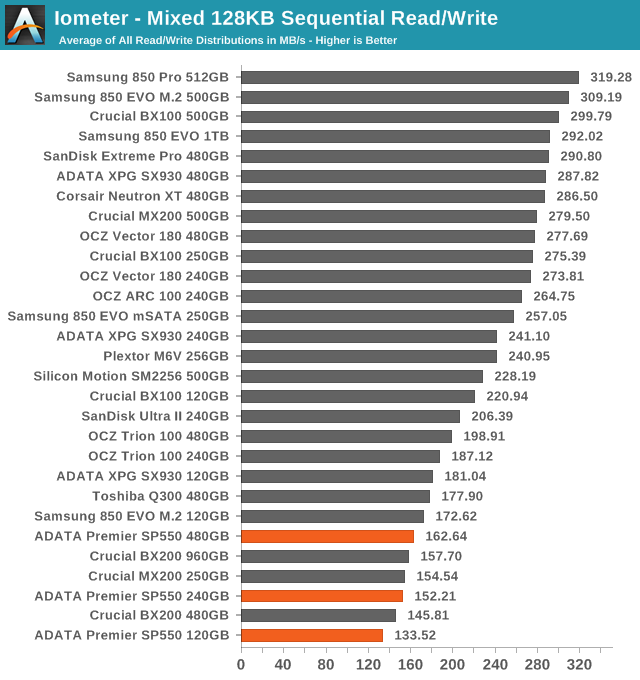
Unlike the mixed random test, the SP550's poor write speeds really hurt it relative to the competition on the mixed sequential test and keep it near the bottom of the chart.
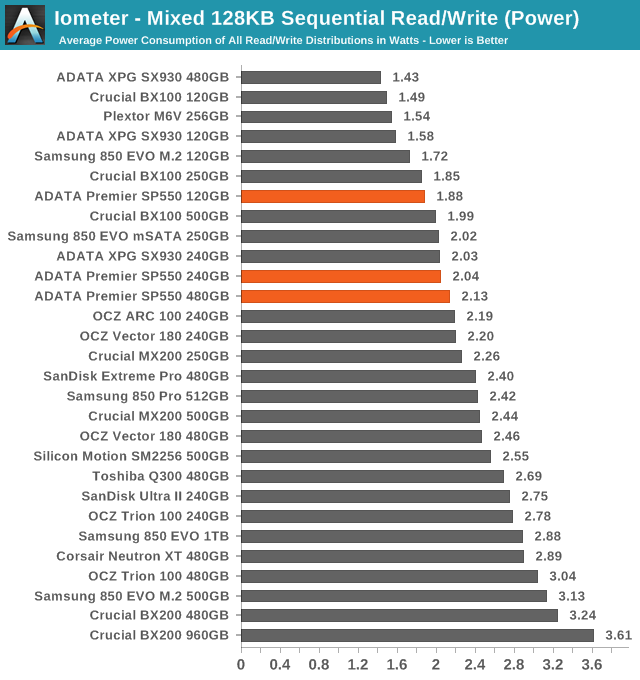
The SP550's power consumption isn't out of control like the Crucial BX200's, but its efficiency is still poor.
 |
|||||||||
Top performers on the mixed sequential test show a U-shaped performance curve and the winner is often determined by which drives suffer least during the middle stages of this test. The SP550 starts out great in the pure-read phase of the test, but it's all downhill from there.










25 Comments
View All Comments
zmeul - Wednesday, March 23, 2016 - link
I have the 120GB version and I'm disapointed in it - after just one month it started showing cell voltage drift and on the 2nd month it gotten worse: https://i.imgur.com/l3zonQn.pngnote: it's on a SATA2
A-Data offers no FW update for this drive
hojnikb - Wednesday, March 23, 2016 - link
Thats pretty much what you can expect with any sub 20nm TLC drive.zmeul - Wednesday, March 23, 2016 - link
well, I wish I knew that before I bought itbut neither Anand or any other site does this kind of "over time" testing
Samus - Thursday, March 24, 2016 - link
Basically you've found out first hand: AVOID any TLC drive, even TLC VNAND from Samsung isn't immune to what you are experiencing. At least you only spent $40. I still think the BX100 and OCZ ARC 100 are\were the best value, but they've spiked in price because they are no longer in production and the BX200\Trion 100/150 are a joke. My cheap go to drives now are Sandisk SSD Plus. Super cheap drive, still MLC, and suspect a reliable Marvell controller. Even the Sandisk Z400s is a reliable drive if you can get over the pretty poor performance...at least it isn't TLC performance.The laws of physics are being toyed with using NAND in TLC mode. You can't reliable store 3 values in a binary state. My childish layman's explanation goes like this: With SLC it was simple because if it was "on" it was a 1. With MLC if it was "on" it was a 1 and if it was "off" it was a 1. Using TLC, if its "on" it's a 1 if it's "off" its a 1 and if its "half" it's a 1. LOL
hojnikb - Thursday, March 24, 2016 - link
Actually, vnand tlc is just fine and possibly better than ~15nm MLC.Much larger cells offset the 3 bit per cell disadvantage.
Samus - Thursday, March 24, 2016 - link
I get that it's 40nm, so "leakage" isn't really an issue, but it still suffers from TLC's inherently poor write performance. I still prefer MLC. Especially since, as it stands right now, MLC and TLC drives are virtually the same price. I still pickup old Crucial M500's and Intel SSD320/X25-M's...and occasionally you can find new M500's in retail (Microcenter has the M550 256GB models for $60 right now)Well, they DID. I bought the last 5 at my local store I guess. http://www.microcenter.com/product/453561/256GB_SA...
They have the M500 240GB new for $67.99. Quality Marvell controller, MLC NAND, proven firmware and reliability. Until TLC drives are half that price for the same capacity I don't see what the big deal is.
KAlmquist - Thursday, March 24, 2016 - link
I'm have a hard time believing that 16nm TLC NAND is a good idea. The problems that Samsung has had with data degradation on the 840 EVO suggests that even with 19nm TLC NAND the cell size is too small. While the reviewed drive is priced attractively, I'd be more inclined to buy an MLC drive, or the Samsung EVO 850, which is TLC but with a large cell size.LarsBars - Thursday, March 24, 2016 - link
The MU02 firmware update for the Crucial BX200 resolved the strange ATTO plots that were mentioned in this review. At least for me.jabber - Friday, March 25, 2016 - link
Mmmmm the BX200. The one I got in to test finally bottomed out at a super 40MBps write speed. That was about 6 weeks ago with the latest firmware then. BX200 = Junk. The BX100, now that was and still is a quality drive.bogdan_kr - Saturday, March 26, 2016 - link
@Billy TallisI would like to ask about AnandTech Storage Bench - Light. How long (typically) does it take to finish this bench?
I mean I can see it is designed to read and write about 41GB of data. SP550 480GB finished it with 299.02 MB/s average data rate score so does that mean it took about 140 seconds?